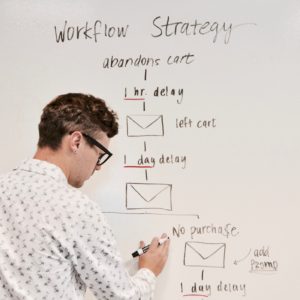How We Work
We work in three distinct stages (“In 3” — get it?) to raise money for client companies. Here’s an overview that includes and compares our flagship (CAP) funding (formerly Capital Guarantee Program) to other pathways. If you are focused on CAP funding, jump to CAP Process instead of this page.
1. Prepare — If not using CAP funding (projects that require less than $25 million or that require all funding in a single draw, or prefer debt only, or are certain that a guarantee is not possible, even with a sponsor), then there is no pre-qualification process available, and we recommend submitting a crystal-clear 1-page overview to market the deal and determine investor interest. Expectations for remaining risks and returns vary widely by type of project, preferred geographic locations, sector preferences, stage of readiness, acceptable equity/debt ratios, IRRs, asset classes for capital, and required team experience. These variables are hard to control/predict, and depend entirely on the target capital provider(s).
Compare that to using In3’s Completion Assurance Program™ (CAP), where you can get to quick yes/no answer via our pre-qualification procedure. Jump to CAP’s process.
2. Package and Present your investment proposal per the investor’s preferred format. There are well-established standards for what most project financiers expect (if you are not familiar, see below or ask us), while CAP is much more forgiving of myriad issues that traditional investors will see as stumbling blocks. The ideal is a “shovel ready” project with no avoidable commercial risk. In practice, such projects rarely live up to the ideal, which can cause delays or get in the way of coming to terms. How long does it take to get a binding offer? Without CAP, the timeframe for a definitive response — let alone getting through due diligence — is largely unknown and is thus anybody’s guess. Time horizons vary with each source of capital on a scale from 1 to 10, where 1’s are extremely pragmatic due to their entrepreneurial impulse to solve problems versus 10’s that are rigid and inflexible, with few options for problem solving due to embodied institutional bureaucracy. We’ve managed to reach closing with CAP funding, probably a 2 on this scale, in less time than it takes just to get a dignifying “we’re looking at it” response from alternative, traditional, private investors.
3. Partner — if the project gets traction (not at all certain without pre-qualification), then the final stage involves some number of meetings followed by assisting In3’s capital partners or introduced investor with their due diligence, then you would normally receive either a binding termsheet or investment agreements (loan agreement and/or share purchase agreement, typically). This is where the process bogs down with most private sources — they bargain for the best possible terms due to perceived risk factors that are seen as minimal by developers.
This dispute over reasonable terms goes unresolved and a waiting game ensues. Investors have little or nothing to lose if they wait for developers to handle and mitigate risk factors they fund unsettling. Thus, if you are operating with time constraints, please carefully consider pre-qualifying for the CAP funding instead. If that’s not possible, skip to the details below.
With CAP, our due diligence process is always less than 30 days (typically only 2 weeks or so) with closings reached once the contracts are signed and completion assurance guarantee received by the funding bank. We are committed to being the fastest provider of mid-market project financing available. Under a separate management services agreement, we can sometimes make quick progress toward such partnerships for sectors we know well.
For further tips and Frequently Asked Questions (FAQs):
- Developers of construction-ready projects in renewables-related industries (any of 30+ qualified sectors), please read in3finance.com/renewables-project-finance.
- Comparison of typical terms for CAP versus the next best alternative (a partner fund that is dedicated to financing projects of $50 million or more, using a more traditional process lasting 2-3 months)
- Completion Assurance Program (CAP) FAQ
- Success Tips
Detailed Funding Process Steps
PREPARATION: In step 1, before contacting us regarding the Completion Assurance Program (CAP), first gather the information basics shown here (items 1-3 or 4 out of the Six Essentials), and then email us with those materials as a package. No need to go any further for now. If you do not hear back within 72 hrs, typically, call us to confirm receipt and to estimate timing for next steps.
If not using CAP, please assess your project’s readiness, then email or call us +1.831-761-0700 Ext 1 to discuss your situation. Together we will quickly understand your project’s opportunities for funding via alternative 100% mid-market project funding pathways, and/or services that will be offered within a well-defined Statement of Work (SOW). To expedite, use this fast and easy assessment (Readiness & Investment Navigator, or RAIN), which helps clarify your chances for success via a financeability score and thorough explanation of what it means in practical terms. This is In3’s automation, “robo” aspect.
Then, when you contact us for assistance, together we assess what work is needed, who will do what (via the SOW), and more accurately pinpoint service fees and timeframes. More on these services here.
Both established companies and new ventures or project companies are welcome. Only a pre-qualified, mid-market project or portfolio under CAP funding usually does not involve initial service fees. Under CAP, or the alternatives, since we know all investment conditions and procedures to qualify and secure the required capital, we eliminate more of the uncertainty and variables of “arm’s length” mid-market project finance, and can thus defer most if not all fees until after closing. Our alternative investors sometimes ask for either a vetting fee or a binding termsheet fee, either of which can be credited upon closing.
We may ask you to consider the need for additional project development, planning or polishing the package of due diligence materials as necessary to achieve financing without delay, or more favorable terms. To receive project financing, read our Frequently Asked Questions, Success Tips, or for projects in emerging markets, consider our 6-point Essentials Guide “Does my situation qualify?” (geared toward US government-assisted loans, but consistent with finance finance bankability standards).
Here are some of the points addressed in our 9-question RAIN assessment:
Does the project use proven technology? Capital for projects with little or no remaining technology risk — using “off-the-shelf” core products, services or technologies that are commercially proven — tend to receive the lower cost (better term) loans. For example, most solar/PV panels now carry a 30-year manufacturer’s warranty. If your core innovation is in the technology itself, consider venture finance, not project finance.
How to Obtain Equity Partners and Securitize Loans: Risk management is an important value-add resulting from using In3’s services.
-
- Contractual arrangements with suppliers or customers help minimize commercial risks (such as power purchase agreements for energy producers), but loan guarantees — sovereign, bank, corporate, leased or personal guarantees, are often requested to further ensure that the lender gets repaid. Such guarantees or partial guarantees sometimes come from the Ministry of Finance for a nation’s government, or can be leased from private, multilateral, development finance institutions, or “sponsors” (partners) that wish to see the company deliver developmental impacts in the form of good, private-sector job creation, cleaner water or air, healthier indoor cooking, or a myriad of other sustainable benefits.
- Existing or new capital assets can be pledged as part of a collateral package to help further secure the loan, through limited-recourse or no-recourse lending (unlike a real estate mortgage).
- Risk insurance can play a helpful role when working in host countries with unstable currencies, policies or government regimes.
Getting Started: To clarify the type, size, and scope of the project we use a one-page pre-qualification form. Send this completed document to us for a free consultation. We may ask you to use our readiness assessment tool (click here) as well. If you have questions, contact us; we are here to help.
Project Development follows pre-qualification screening. This step begins with discovery of the project’s status, including geographic placement, managers and sponsors, and overall financial situation:
– Who are the players and what is the scope of the project?
– Total budget, estimated costs and amount of finance?
– Ownership structure (host country and US ownership/involvement)?
– Assets organized and listed in one place?
– Is there a business plan or other prepared documentation?
Our Value-Add: We work with identified gaps that may influence your probability of success. We speak fluent “investor” — the language used by accredited individuals, investment funds, banks and non-bank finance institutions — to help you step into their shoes and gain mutual understanding and respect from the get-go. We’ve run numerous successful venture fundraising campaigns and originated loans for complex projects using these best practices and tools, making the process easier and more systematic.
Further, we can spot risk factors and other “out of bounds” conditions that can get in the way of investor support. Our objectivity and training gives project teams the opportunity to adjust presentations and plan proactively, making most projects financeable and bankable without the risk of making the wrong impression or being turned down by a desirable source of capital. And we usually know which ones are desirable.
How we work: Typical project development entails setting up one or more conferences and/or meetings with key personnel and/or government officials, sometimes restructuring (such as setting up a legal entity where the project is to be located, or through a joint venture with additional partners), or others strategic considerations as needed to secure capital.
PRESENTATION: Step 2 actions depend on the target investor(s), where some prefer to meet in person — a pitch session with deal screeners followed by one or more subsequent meetings with decision makers — while others prefer to use a more anonymous and formal, online application system.
What are the expectations of each investor, including
- the time they are willing to invest up front
- values and principles, sense of responsibility or mission, their true “hot buttons” and “sweet spots”
- appetite for risk
- financial ratios, such as debt-to-equity, debt service coverage, expectations for return, etc.
- appetite for detail — what facts must be presented first before other specifics will be heard?
- cultural or geographic considerations, such as what regions, countries, languages or currencies they prefer…
We facilitate and streamline this process to hit the mark and gain “traction” (investor interest), faster and easier than our competitors. We shave off at least 30% of the time it takes to attract investment at favorable terms.
PARTNERSHIP: In Step 3 we use information collected in steps 1 and 2 for the due diligence process, leading to procurement of capital investments, and advise or consult with the company principals as necessary to satisfy investor requirements, provide supplemental information (updated financial statements is the most common request), and when necessary, remove any remaining, perceived issues or risk factors.
Our track record shows we have learned how to navigate all these complexities to help you find and partner with sponsors and other investors that “get it.” It is essential that companies ONLY accept capital from investors with whom you share values and principles. (Long-term institutional debt is less about values alignment than equity or other forms of capital.) A values mismatch can lead to unimaginable horror stories — investors driving your otherwise viable business into the ground, taking over or enforcing their preferences through voting rights. When we help companies source and screen equity investment capital, this is imperative, and part of how we do business.
Next Steps:
- Contact us to describe your situation and possible fit with our services, or
- Jump in and use our project Readiness Assessment then Contact us and share your RAIN score.
If you’re not yet clear on project scope or goals, looking for additional partners or technical solutions, or want to assess market opportunities, competitive situation or your chances of receiving needed funds, see related services or contact us to discuss.




